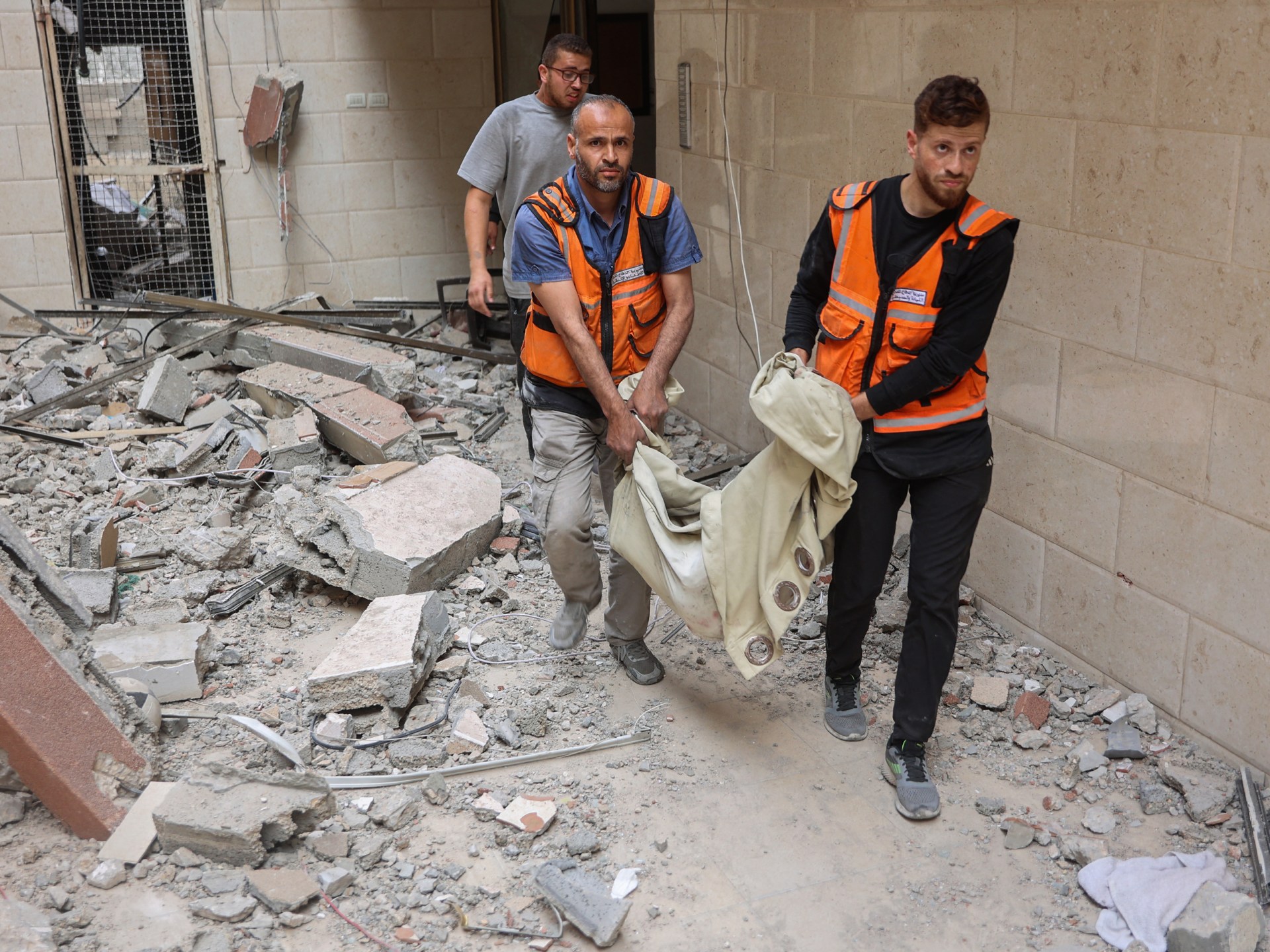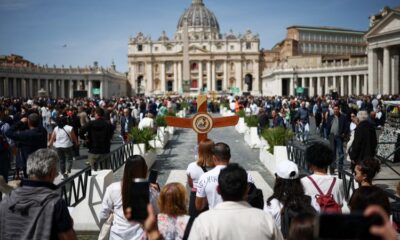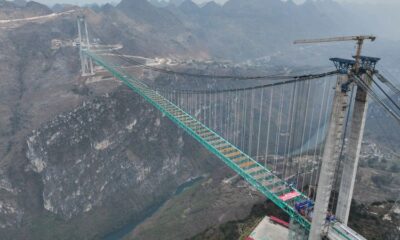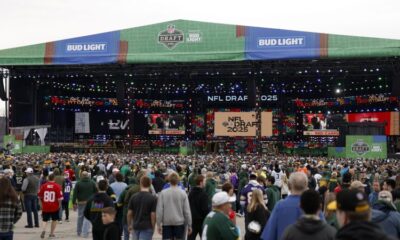Middle East
Thirteen killed, dozens under rubble as Israel bombs Gaza amid food crisis | Israel-Palestine conflict News

The entire Strip, with a population of two million people, may be on the brink of famine as the World Food Programme runs out of supplies.
At least 13 Palestinians have been killed since dawn and dozens of others buried under the rubble of a building destroyed in an Israeli air attack on Gaza City.
Four victims, at least, were killed in a strike on a home in the city’s Sabra neighbourhood on Saturday, with the residents forced to dig the ground with their bare hands to reach people buried in the debris.
Mahmoud Basal, spokesman for Gaza’s civil defence agency, said a lack of rescue equipment has prevented emergency workers from reaching those buried underneath the collapsed building bombed by Israel before dawn.
“Our crews cannot reach them because of the lack of the necessary machinery,” he told the AFP news agency.
Earlier this week, Israeli aircraft destroyed 40 engineering vehicles the civil defence teams were using to remove heavy debris during rescue operations.
Israeli air raids also hit other parts of the Strip on Saturday, including al-Mawasi and Khan Younis, as the besieged territory faces impending mass starvation amid an ongoing genocide.
After 18 months of the Israeli military invasion that has killed more than 51,000 Palestinians, the situation in Gaza “is probably the worst” it has been, the United Nations warned.
The UN’s World Food Programme (WFP) on Friday said the entire Strip, with a population of two million people, may be on the brink of famine and aid kitchens are “expected to fully run out of food in the coming days”.
Israel’s ongoing blockade has meant no food, fuel or medicine has entered Gaza for two months. For many Palestinians in Gaza, community kitchens were their only source of nutrition after Israeli forces destroyed almost all food production facilities.
WFP has appealed to the international community to put pressure on Israel to lift the blockade, saying more than 116,000 metric tonnes of food assistance – enough to feed one million people for up to four months – are already positioned for delivery “as soon as borders reopen”.
Reporting from Deir el-Balah on Saturday, Al Jazeera’s Tareq Abu Azzoum said the humanitarian crisis in the besieged territory “has reached a very unprecedented breaking point”.
“Civilians are really struggling to cope with this crisis,” he said.
Philippe Lazzarini, head of the UN Palestinian refugee agency UNRWA, said the crisis was “man-made”.
Michael Fakhri, UN rapporteur on the right to food, said Israel is “executing this starvation campaign with no repercussions”.
The World Health Organization said the situation was no different for medical supplies, with WHO chief Tedros Adhanom Ghebreyesus pleading on X for the aid blockade to end.
At least 2,062 people have been killed in Gaza since Israel resumed its deadly campaign against Hamas on March 18, and more than 50,000 since October 7, 2023. Hamas’s attack on Israel killed 1,218 people, mostly civilians.
Middle East
Israel bombs Beirut; President Aoun calls for international pressure | News

Israel has violated the November ceasefire multiple times, attacking the Lebanese capital and the south.
Israel has struck Beirut’s southern suburbs after issuing an evacuation warning, the third Israeli strike on the Lebanese capital since a ceasefire took effect in late November.
A huge plume of smoke rose over the area after the strike on Sunday. There was no immediate word on casualties.
Lebanese President Joseph Aoun condemned the air strike and called for France and the United States, guarantors of the November 27 ceasefire between Israel and Hezbollah, to compel Israel to halt its attacks. Israel has violated that truce multiple times in recent months and weeks with attacks on the capital and across southern Lebanon.
Aoun said Israel is undermining stability in Lebanon and escalating tensions, posing “real dangers to the security” of the region.
The Israeli military said the attack on Beirut destroyed “an infrastructure where precision missiles” were stored by Hezbollah. It did not provide proof for its claim. No secondary explosions were reported after the Israeli attack.
Local platforms have published footage filmed in the immediate aftermath of the bombardment. This video has been verified by Al Jazeera:
بالفيديو: دخان كثيف يتصاعد من “الهنغار” المُستهدف في منطقة الحدث بالضاحية الجنوبية pic.twitter.com/nLle4DuG8I
— هنا لبنان (@thisislebnews) April 27, 2025
‘Damage widespread’
Al Jazeera’s Zeina Khodr, reporting in Beirut, said: “We were able a short while ago to reach the site that was targeted, but there was a lot of chaos, and we were told to leave.”
“The damage was widespread, also affecting nearby buildings. Windows were blown out, glass was on the floor, cars were damaged,” she added.
“This strike did come with a warning but without any provocation,” Khodr said. “This is not the first time that Beirut’s southern suburb has been hit since Israel and Hezbollah agreed to that ceasefire back in November, but this time, there was no rocket fire. So people here are concerned that Israel is rewriting the rules of engagement, saying that there are no red lines any longer and that this could be the beginning of an escalation.”
‘Pinging the system’ for intelligence
Elias Hanna, a retired Lebanese army general, told Al Jazeera the Israeli strike on Beirut – and the warning that preceded it – may have been aimed at gathering intelligence on Hezbollah.
Hanna said such an operation is known as “pinging the system”.
“If you have information on certain individuals or facilities, you send the warning, and you wait to see how these officials or leaders will respond,” he said. “Will they move from one place to another?”
Hanna added that the operation could confirm or dismiss certain information, which would be a “win-win” scenario for intelligence gathering.
During the yearlong war, Israeli drones and fighter jets regularly bombarded the southern suburbs of Beirut, where Hezbollah has widespread influence and support. Israel assassinated several of Hezbollah’s top leaders there, including Secretary-General Hassan Nasrallah.
The US has pressured Lebanon to disarm Hezbollah, but Aoun has warned this is a “delicate” matter that must be handled in a way that preserves peace in the religiously diverse country. Hezbollah, which views itself as the resistance to Israel, says it will not disarm.
Middle East
‘A tree is worth more’: The civilians who fled Zamzam as the RSF attacked | Sudan war News

One dawn in mid-April, the very air in Zamzam Camp seemed to shatter.
The paramilitary Rapid Support Forces (RSF) stormed the displacement camp in North Darfur, launching a brutal three-day assault that killed hundreds of people and left countless others scattered, injured or missing.
Gunfire echoed through makeshift shelters. Families ran in every direction. Many never made it out.
On April 13, the RSF claimed to have captured what it called the “Zamzam military base”. But those living there said no such thing existed, that Zamzam was simply where displaced families clung to life.
The takeover followed five months of suffocating siege. Roads and aid were blocked, and survival left to chance.
A shelter turned into a battlefield
Zamzam, 15km (9.3 miles) south of el-Fasher, the capital of North Darfur state, has been a refuge for civilians displaced by the Darfur conflict since the 2000s.
At the time, rights groups said the violence was ethnic cleansing and possibly genocide by state-backed “Arab” nomadic militias against mainly “non-Arab” sedentary communities.
About 300,000 people have ended up in Zamzam since 2003. The number swelled to well above 500,000 due to violence that has spread across the western region of Darfur since Sudan’s civil war erupted between the RSF and Sudanese military in April 2023.
In the past year, Zamzam has transformed from a place of refuge into a killing field.
Aid blockades, repeated RSF attacks and famine have stripped the camp of food, medicine and basic security.
The military and its allied forces managed to repel dozens of RSF assaults, but the troops soon returned to el-Fasher, their last stronghold, leaving the camp exposed once again.
Dr Ibrahim Abdallah, director general of health in North Darfur, told Al Jazeera over the phone that the death toll likely exceeds 500.
“Due to the Sudanese tradition of burying the dead immediately to honour them, it’s hard to keep track,” he said. “And with Zamzam located many kilometres from el-Fasher, transporting the bodies for documentation is nearly impossible.”

Fleeing one nightmare, only to find another
A young woman, who asked to remain anonymous for her safety, spoke to Al Jazeera from el-Fasher, to which she, her husband and her two younger brothers fled.
She says fear has followed them and told Al Jazeera part of the story of how she came to flee Zamzam.
In January 2024, she had been living with her husband in Wadi Shadra in North Darfur with her 15-year-old and 9-year-old brothers, who moved in with them after her parents died.
The RSF attacked Wadi Shadra, and the blended family fled to Zamzam, where they thought they had escaped the worst.
But then, just over a year later, another attack.
“It started at dawn on Friday [April 11],” she said. “A large force stormed the camp from the south, towards one of the markets. Fire broke out in every direction as gunfire rang out.”
They hid in trenches for a full day without food or water as a shell shattered their home and another struck a neighbour’s, killing three children.
Then they ran, fleeing to the nearby village of Saluma.
“But the RSF followed us there too. They torched the houses and shouted that we must go to Tawila immediately,” she said.
Their donkey had been killed and their cart destroyed, so they had no other option than to walk for hours to el-Fasher under a blazing sun.
“I lost my aunt and two of her children that day. We still don’t know what happened to her other three children.”
Trapped away from his family: Nasr’s story
Nasr, who asked to be identified by just one name, fled Zalingei, the capital of Central Darfur, with his family in October 2023 after RSF fighters took the city. His father, a community leader, had twice been threatened by the late RSF commander Ali Yakoub.
The family passed through Sarf Omra, in Kabkabiya, North Darfur, before arriving in Zamzam on November 22, 2023.
He arrived with his wife, two children – a spirited three-year-old daughter and a toddler son just over one and a half years old – as well as his parents and several siblings.

Together, they built a fragile shelter and tried to start over. Each morning, Nasr made the 30km (18.6-mile) round trip to el-Fasher to work in the livestock market and bring home food.
Then, in February, RSF fighters stormed the camp. Roads were closed. The siege tightened.
Nasr never made it back to his family.
His wife, children, elderly parents and younger siblings remained behind, caught in the chaos.
“A tree is more valuable in this world than we are. We lost all our human value in this world,” Nasr said.
He rejected the RSF’s claim of a “military base” in Zamzam as a cruel distortion. He recalled how people dug trenches to shield themselves from relentless bombardment.
He later saw a video of detained men, among them his uncle. One of the RSF leaders delivered a clear message to them: “Join the RSF or suffer.”
Nasr has spent agonising days in el-Fasher, waiting by roadsides, clinging to hope that someone from Zamzam might bring word of his family.
He asks about them in whispers, his voice heavy with fear.
At last, he heard they had fled towards Tawila, but he adds: “Until now, I don’t know if they reached Tawila or not.”
‘More than 28 attacks in five months’
Mohamed Khamis, spokesperson for the displaced in Zamzam, is now a patient in a hospital in el-Fasher.
He was shot in the thigh during the RSF’s assault.
The camp had endured more than 28 attacks in five months, he told Al Jazeera, but none matched the scale and violence of the latest.
“They stormed in at dawn with heavy weaponry,” he said.
In the early moments of the attack, they reportedly targeted a Relief International Clinic, and Khamis rushed to check on friends, but he never made it.
“I was intercepted by an armoured RSF vehicle,” he said.
The RSF fighters shot him and left him on the ground to bleed out, but he was rescued by residents and smuggled to safety.

“Many young men were executed during the rampage,” he said.
He continued, trying to describe what happened.
More than 12 women and girls were confirmed to have been abducted by RSF fighters while fleeing. Their whereabouts remain unknown, as well as what they may be suffering.
There are reports of women and girls being raped, “no fewer than 200 cases” according to Khamis, although he is certain many more have gone unreported.
No safe haven left
In the minds of those displaced for the second or third time, the idea of safety is gone.
The RSF narrative is that it is fighting “military elements” in Zamzam, but testimonies like Nasr’s and Khamis’s refute that.
“There was nothing there but people trying to survive,” Nasr said again, as if repetition might finally end the world’s indifference.
But the silence remains.
Survivors are left with ashes, unanswered questions and a single haunting truth: “We lost our human value in this world.”
Middle East
Iran’s President Pezeshkian visits injured, site of deadly port explosion | News

The fiery blast at the Shahid Rajaee port in southern Iran has killed at least 40 people and wounded some 1,000 others.
Iran’s President Masoud Pezeshkian has visited hospitalized survivors of a huge explosion that rocked one of the country’s main ports, killing at least 40 people and injuring about 1,000 others.
The visit on Sunday followed a massive blast the day before at the Shahid Rajaee port outside of Bandar Abbas in southern Iran’s Hormozgan province.
Arriving at the site, Pezeshkian thanked first responders, announcing, “We have come to see first hand if there is anything or any issue that the government can follow up on.”
“We will try to take care of the families who lost their loved ones, and we will definitely take care of the dear people who got injured,” he said.
Later Sunday, Iran’s Supreme Leader Ayatollah Ali Khamenei said “security and judicial officials are obliged to thoroughly investigate, uncover any negligence or intent, and follow up in accordance with regulations”, in a message carried by state television.
Meanwhile, Russia’s embassy said Moscow was sending multiple “aircraft carrying specialists” to help fight the blaze. According to Russia’s Ministry of Emergency Situations, one of the aircraft is a dedicated firefighting plane.
The facility has been purportedly linked to an earlier delivery of a chemical ingredient used to make missile propellant.
But Iranian Defence Ministry spokesman Reza Talaei-Nik told state TV that “there has been no imported or exported cargo for military fuel or military use in the area”.
The port’s customs office said in a statement carried by state television that the explosion probably resulted from a fire that broke out at the hazardous and chemical materials storage depot.
Iranian state television also described the fire as being under control, saying emergency workers hoped that it would be fully extinguished later on Sunday. Overnight, helicopters and heavy cargo aircraft flew repeated sorties over the burning port, dumping seawater on the site.
Also at the scene on Sunday, Interior Minister Eskandar Momeni said “the situation has stabilised in the main areas” of the port, and workers had resumed loading containers and customs clearance.
Another official on site, Minister of Roads and Urban Development Farzaneh Sadegh, said only one zone of the port was impacted, and cargo “operations are still continuing as normal in the several other zones”.

Images from the scene showed firefighters working among toppled and blackened cargo containers, and carrying out the body of a victim.
The authorities have closed off the roads leading to the site, and footage from the area has been limited to Iranian media outlets.
Authorities have also declared a day of national mourning on Monday, and three days of mourning in Hormozgan province from Sunday.
Meanwhile, messages expressing solidarity with Iran and victims of the blast have poured in from around the world.
The United Arab Emirates noted “solidarity with Iran” over the explosion and Saudi Arabia sent condolences, as did Pakistan, India, Turkiye, Russia and the United Nations.
Lebanon’s Hezbollah also offered condolences, saying Iran, with its “faith and solid will, can overcome this tragic accident”.
In the first reaction from a major European country, the German embassy in Tehran said on Instagram: “Bandar Abbas we grieve with you.”
China’s Foreign Ministry said in a statement to AFP on Sunday that three Chinese victims were in a “stable” condition.
-

 Education1 day ago
Education1 day agoHavard students and faculty face the fallout from a showdown with Trump
-

 Sports1 day ago
Sports1 day agoBoston Celtics criticize Orlando Magic’s physicality after another injury in Game 3 loss
-

 Europe1 day ago
Europe1 day agoLive updates: Funeral of Pope Francis, interred at Santa Maria Maggiore
-

 Europe2 days ago
Europe2 days agoRecord-breakers, from the world’s tallest bridge to the world’s smallest park
-

 Sports2 days ago
Sports2 days agoPittsburgh Steelers’ first-round draft pick loses mother hours after being selected
-

 Lifestyle2 days ago
Lifestyle2 days agoA bushel of fruit and vegetable motifs give decor a healthy farmstand vibe
-

 Sports1 day ago
Sports1 day agoLondon Marathon: Why more people than ever before are running marathons
-

 Sports1 day ago
Sports1 day agoTrendlines: Everything about the NFL draft is trending up




